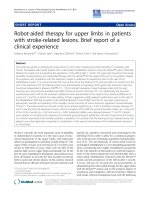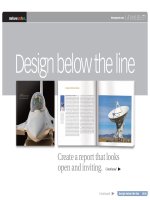- Trang chủ >>
- Luật >>
- Luật doanh nghiệp
design project report botschool a personal assistant robot in universities
Bạn đang xem bản rút gọn của tài liệu. Xem và tải ngay bản đầy đủ của tài liệu tại đây (573.28 KB, 29 trang )
<span class="text_page_counter">Trang 1</span><div class="page_container" data-page="1">
DESIGN PROJECT REPORTS
DESIGN PROJECT REPORT: BOTSCHOOL – A PERSONALASSISTANT ROBOT IN UNIVERSITIES
GROUP 4
Team leader: Nguyen Mai Vi - 21080191
Hanoi 12/2023Abstract
The university landscape is rapidly evolving, and there is an increasing demand for innovativesolutions to meet the needs of modern education. To address this, our AI-enabled support robotproduct aims to revolutionize the university experience.
Our goal is to provide an intelligent and versatile robot that caters to the specific needs ofstudents and faculty members in an academic environment. With its proactive capabilities, thisrobot will empower users to navigate their educational journey with ease and efficiency. Throughthe utilization of advanced AI technology, we propose a solution that enhances studentengagement and learning outcomes. The robot will serve as a reliable and personalizedcompanion, providing customized support, answering queries, and offering real-time assistance.By leveraging its advanced features, such as integrated attendance tracking, appointmentscheduling, directions, and gathering student feedback on courses, the robot will adapt toindividual learning styles and preferences. Furthermore, this AI-supported robot will facilitateseamless collaboration between students and educators. It will foster interactive discussions,provide valuable insights, and contribute to the overall improvement of the educational process.Its ability to analyze data and provide useful recommendations will revolutionize the design ofcourses, ensuring they align with the increasing needs of students and industries.
</div><span class="text_page_counter">Trang 2</span><div class="page_container" data-page="2">3. Revised Needs Statement and Target Specifications...5
3.1 Revised Needs Statement...5
7.1 How does it work?...15
7.1.1 Central processing unit (CPU)...17
7.1.2 Smart Camera...18
7.1.3 LCD Touchscreen...20
7.1.4 Mic Array Module...22
7.1.5 Brushless DC Motor...23
7.1.6 Obstacle Avoidance Sensor Module...24
7.1.7 Battery and Charger...25
7.1.8 Loudspeaker...26
7.2 How is it manufactured and assembled, and what does it cost?...27
7.2.1 Details of some important parts...27
7.3 Design Drawings, Parts List and Bill of Materials...33
8.0 Conclusions...34
Appendices...37
</div><span class="text_page_counter">Trang 3</span><div class="page_container" data-page="3">1.0 Introduction
In today’s fast-paced evolution of technology, personal assistant robots have become ubiquitousand have been used as assistants in different industries such as hospital, factory and education. Apersonal assistant robot is an artificial intelligence (AI) used for assisting human activities andimprove people’s quality of life (Transform your Daily Life with these Assistant Robots, 2022).
(Number of personal assistance robots worldwide from 2020 to 2030, 2023)
According to Statista, the number of personal assistant robots throughout the world is forecastedto soar to more than 244 million by 2030, an increase of more than 220 million compared to2020. Therefore, we can see the enormous potential of personal assistant robots in human life,especially as the population and urbanization continue to increase. Normally, this type of robot isknown for its role in assisting humans with daily household tasks. However, we want to apply itto help and amend students’ lives in universities.
At universities, students may face various challenges from academic to personal issues such asmaking appointments with lecturers, finding directions or doing roll call. In order to solve theseproblems and aid students through their university life, the AI robot will be designed andintegrated multiple features to cover the difficulties. This study will directly investigate the needsof students in academic environments and explore the mechanism and operation of the personalassistant robot.
2.0 Customer Needs Assessment
Table 1: Initial Customer Needs List Obtained from Interviews and Observations
</div><span class="text_page_counter">Trang 4</span><div class="page_container" data-page="4">Easy to useQuickly
Easy and modern operationUser friendly
Low noiseSmart interfaceMultiple languagesTouching screen
Integration of multiple features.Delivery ability
1.2 Easy and modern operation1.3 Fast access speed2. User friendly
</div><span class="text_page_counter">Trang 5</span><div class="page_container" data-page="5">2.1 Low noise2.2 Smart interface 2.2.1 Multiple languages 2.2.2 Touching screen3. Versatile
3.1 Integration of multiple features. 3.1.1 Delivery ability 3.1.2 Map (Showing the way) 3.1.3 Cleaning up ability
3.1.4 Quality assessment of lecturers4. Security
4.1 Timekeeping and roll call via Facial Recognition Technology5. Schedule an event
2.1 Customer Needs
Before designing, we need to understand the needs of customers as well as the required functionsof a smart robot. In the next step, we need to identify what traditional activities are lacking andcannot meet the needs of target customers. To better understand customer goals, we importedinformation from various websites or information through surveys or in-person interviews.Through a survey of common problems encountered by students and lecturers that conducted byour team, we compiled the following information.
70.1% of students are often late for attendance and about 64% of them have difficulty findingtheir classes. The remaining problems are traffic jams, not having time to eat breakfast, etc.Besides, up to 92.2% of students having troubles with arranging class schedules and examschedules. When it comes to making appointments with lecturers, about 68% of students usetraditional methods such as contacting the student office or actively looking for a contact phonenumber, while about a third of the students use email to interact with lecturers. Not only that,there are still many students, typically freshers, who say they still have difficulty finding aclassroom, the specific number is 85.7%.
Not only students, lecturers also have many difficulties in schools. The majority of lecturersperceive that they have to spend a lot of time in the morning waiting for timekeeping becausesometimes the timekeeping machine fails. Up to 75% of lecturers surveyed felt their workloadwas overwhelming, making it difficult for them to balance work at workplace and work at home.Specially, almost students and lecturers surveyed long to solve outstanding problems that arehindering their time and spirit. In general, they offer various solutions to address encountered
</div><span class="text_page_counter">Trang 6</span><div class="page_container" data-page="6">issues such as improving the attendance and check-in system, reminding of exam schedules andclass schedules, displaying class information on the shared screen and so on. Remarkably, up to55.4% of people want to use "Personal AI Assistant Robot" to address all their problems.Through the survey, it can be seen that users have the most difficulty in marking time forlecturers and taking attendance for students. Besides, there are many problems in arranging classschedules and teaching schedules. Therefore, they really want to tackle with or have a productthat can solve their above problems, not just stop at improving the usual traditional methods.From the information we collected from students and lecturer who may be our target customers,the idea we came up with is "BOTschool - Personal AI Assistant Robot" with many featuresintegrated to support them to accomplish daily tasks effectively. Last but not least, a lot ofoptimal ideas, modifications, and action plans can be scrutinized to increase the likelihood ofmarket launch success.
3. Revised Needs Statement and Target Specifications
3.1 Revised Needs Statement
Objective: To create a versatile, intelligent product integrating various features that promoteinteraction and connectivity within an educational environment, aiming to deliver an optimallearning and teaching experience for both students and educators.
Target users: Involving students, educators, and educational institutions. Students seek aflexible tool allowing seamless access to information, easy navigation, and convenientscheduling with teachers. Educators anticipate a classroom management tool to oversee studentattendance and optimize the teaching process. Educational institutions require an efficientsolution to enhance the learning and teaching experience within their academic settings.
Target Customers: Universities or educational institutions aiming to enhance the learning andteaching experience through technology. Educational administrators seeking technologicalsolutions to optimize the learning and teaching processes.
Requirements: Essential product features include:Lookup Information
Have map and Flexible movement
Helping to make an appointment with lecturers
Facial Recognition Technology cameras to check attendanceUser-friendly interface
High safety and durability standards
3.2 Objective Specification
Lookup Information: This robot will assist both students and educators in searching forinformation from various sources: study materials, teaching information, or subject supportinformation... Users can search for information by entering keywords or topics, and the mostaccurate results will be displayed on the screen. This search method will be integrated into a
</div><span class="text_page_counter">Trang 7</span><div class="page_container" data-page="7">user-friendly interface of the robot with intelligent search features, helping users save time infinding information, facilitating easier lesson preparation, and enabling smoother research. Have map and Flexible movement: The robot will be equipped with a school map function thatenables flexible positioning and movement within the learning environment. Users canselect/input their desired destination, and the robot will display the map on the screen along withinstructions to guide users to their destinations as needed. Its intelligence and flexible movementwill aid in adjusting routes and avoiding obstacles. The combined benefits of a map and mobilenavigation guidance provided by the robot will help users save time in locating classrooms ordesired locations within the school premises.
Helping to make an appointment with lecturers: Aids students in easily and convenientlyscheduling appointments with teachers. Students can request to schedule meetings with teachersbased on their personal needs or study schedules. This feature allows students to choose theteacher they want to meet, select a time, and submit appointment requests simply. This helpsstudents and teachers manage their time more flexibly and facilitates effective interactionbetween them during the study and discussion.
Facial Recognition Technology cameras to check attendance: Facial recognition technologyusing cameras to automatically and accurately mark student attendance in class. When studentsjoin a class, the system will scan and identify faces, record attendance information, andautomatically update the attendance list. This eliminates the need for manual attendance takingby teachers, saving time during class and ensuring the rights of students attending class. Thisfeature supports more efficient classroom management.
User-Friendly Interface: Provides users with a convenient and user-friendly experience. With asimple and intuitive interface, users can easily interact with and use the product's featuresnaturally. Icons, menus, and functions are logically arranged, making it easy for users to findinformation. Colors, structure, and font are carefully chosen to create a visually appealingexperience, allowing users to focus on using the product without difficulty in interaction.
Safety and High Durability: The product is designed with top priority to ensure safety for usersand the surrounding environment. The BOTschool robot is equipped with sensors andtechnology to avoid collisions, minimizing the risk of harm to individuals or materials aroundduring its operation. Moreover, it's designed to meet durability requirements and maintain stableoperation in educational environments. With high-quality materials and thorough inspections, theproduct can withstand harsh working conditions and has a high lifespan.
4. External Search
In this high-tech progression, there are numerous artificial technologies available to customersand users but some of the most popular ones are personal assistant robots. They are a sum ofhardware and software that influence in a particular way the interaction between users and theyare constantly progressing based on the exchanged information. Furthermore, they use naturallanguages to communicate with users and able to provide a response on time. With assistance of
</div><span class="text_page_counter">Trang 8</span><div class="page_container" data-page="8">searching information, customers and users will accomplish tasks through natural languages inwritten or spoken form (Corina Pelau, Maria Barbul, Irina Bojescu, 2022)
119.5 x 52.1 x51.6Weight
2 x 13 Megapixel Unified Pan/Tilt/Zoom Module
Camera: 13Megapixel HD(photo), 1080p
- Up to 8 Hours of operation per charge- Autonomous charging- 220V/110V - Lithium-Ion cells
Lithium-ion Battery Dimension: 30.0Ah/795Wh- 12 hours of operation
4 hours ofruntime, 2 hourrecharge time Li-
Display <sup>13.3 inch multi-</sup><sub>touch LCD screen </sub> <sup>10.1 inch tablet on</sup><sub>the robot's chest </sub>
9.7 inch backlit multi-touch LCD
LED-11.6-inch touchscreen
We can easily observe that Pepper and Cruzr are heavier than the other two products, withweights of 28 kg and 63 kg, respectively. At the same time, the prices of these products arerelatively high, at $18,506 and $24,946, respectively. In the field of intelligent AI robots, a highprice compared to the general market can make customers hesitate about their budget and reducetheir purchasing ability. Moreover, Pepper and Cruzr are integrated with many advancedfeatures, which may be excessive for the target customers and in academic environments.Therefore, we will focus on the quality of each feature to best address the needs of users andcustomers, instead of integrating too many outlying features. For the robot's screen, we will
</div><span class="text_page_counter">Trang 9</span><div class="page_container" data-page="9">choose a 13.3-inch screen like the temi robot instead of smaller screens. We believe that this sizeis sufficient for users to operate and allows the robot to display information and interact betterwith them. To ensure the robot operates well with the integrated features, we will consider usinga Lithium-Ion battery with sufficient capacity for continuous operation for 8 to 10 hours.
4.2 Business Opportunity
Students are the future of the country, so supporting students to study and work is alwayssomething that the country cares about. We found that students in universities often complainabout long attendance, difficulty making appointments with lecturers, or remembering necessaryschedules during their studies. Therefore, BOTschool is an AI robot product, as an assistant tosupport all activities of student life in the school. The market currently has many lines of robotsto serve and support people in many fields such as health, finance, services and so on, but has notachieved much success in the Vietnamese market. This is an opportunity for businesses todevelop BOTschool to optimize student life in general, and will be a potential product and meetthe needs of universities. Not only that, the personal AI assistant robot also integrates the mostmodern features, improvements from previous products in the same line with outstandingfeatures such as infrared sensors, facial recognition, LCD touch screen, voice adjustment inmany different languages, and information systems that are directly integrated with the school'sdata set. Enterprises can capture those aspects as a strength to compete with the market andbecome products with huge revenue, bringing great commercial opportunities not onlydomestically but also internationally.
Business Opportunity Statement in Appendix
5.0 Concept Generation
5.1 Problem Clarification
The problem at hand is the need for an advanced attendance management and informationsystem using a multifunctional robot. The goal is to automate the attendance tracking processwhile providing additional features such as information lookup, map navigation, appointmentscheduling with lecturers, and flexible and autonomous movement.
</div><span class="text_page_counter">Trang 10</span><div class="page_container" data-page="10">sensors, to assist with autonomous movement.Outputs:
1. Attendance Records: The robot provides attendance records based on the facial imagescaptured and processed by the facial detection system.
2. Information Display: The robot displays requested information, such as course schedules,map navigation, campus events, FAQs, or general knowledge, on the smart touch screeninterface.
3. Navigation Instructions: The robot generates navigation instructions and displays them onthe touch screen interface to guide users through the premises.
4. Appointment Confirmations: The robot confirms and schedules appointments withlecturers, sending notifications to both users and lecturers.
5. Voice Responses: The robot responds to voice commands with appropriate actions orspoken information.
6. Movement and Navigation: The robot autonomously moves and navigates within theenvironment based on user instructions, obstacle detection, and predefined paths.The black-box model takes inputs from facial images, user touch inputs, voice commands, andenvironment sensors. It processes the facial images using facial detection technology to trackattendance and record attendance data. The user touch inputs are interpreted by the smart touchscreen interface, providing information, map navigation instructions, and appointment
</div><span class="text_page_counter">Trang 11</span><div class="page_container" data-page="11">scheduling. Voice commands are analyzed and executed by the voice interaction system,generating appropriate responses or carrying out requested actions.
In addition to the existing outputs, the black-box model includes the capability for autonomousmovement and navigation. The robot uses environment sensor inputs to detect obstacles,proximity, or other environmental factors. Based on user instructions and obstacle detection, therobot generates movement instructions to navigate within the environment. This allows the robotto move autonomously and flexibly, adapting to the surroundings while carrying out attendancechecks, providing information, and fulfilling user requests.
The outputs of the black-box model include attendance records, information display on the touchscreen interface, navigation instructions, appointment confirmations, voice responses, andmovement instructions for autonomous navigation.
By incorporating autonomous movement, the attendance checking, information, and autonomousmoving robot offers a comprehensive solution that combines attendance management,information provision, appointment scheduling, and flexible movement within an educationalsetting.
</div><span class="text_page_counter">Trang 14</span><div class="page_container" data-page="14">7.3 Design Drawings, Parts List and Bill of Materials
Design drawingsPart Quantity Material Size (mm) <sup>Total weight</sup><sub>(gram)</sub> <sub>cost ($)</sub><sup>Total</sup>
</div>








